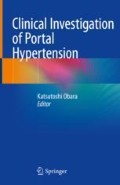Abstract
Spontaneous bacterial peritonitis (SBP) is an infection of ascites that occurs in the absence of an apparent source of infection. Bacterial translocation from the gut plays an important role in developing SBP. Bacteria that eventually cause SBP can also originate from sites other than the gut via bacteremic seeding. The vast majority of patients with SBP have advanced cirrhosis. Although SBP patients develop symptoms such as fever and abdominal pain, some have no signs or symptoms of infection at the time of diagnosis. Early diagnosis is a key issue in the management of SBP. Patients with ascites admitted to the hospital should undergo abdominal paracentesis. The ascitic fluid should be tested for aerobic and anaerobic cultures, white blood cell count and differential, and fluid chemistries. A confirmed SBP diagnosis requires a positive ascitic fluid bacterial culture, with an elevated ascitic fluid absolute polymorphonuclear leukocyte count and without any evidence of an intra-abdominal surgically treatable source. Pathogens commonly associated with SBP include Escherichia coli, streptococcal species, and Klebsiella pneumoniae. As appropriate therapy is necessary for a good prognosis, a clear distinction is crucial (or mandatory) between secondary bacterial peritonitis and SBP.
Access this chapter
Tax calculation will be finalised at checkout
Purchases are for personal use only
References
Borzio M, Salerno F, Piantoni L, Cazzaniga M, Angeli P, Bissoli F, et al. Bacterial infection in patients with advanced cirrhosis: a multicentre prospective study. Dig Liver Dis. 2001;33:41–8.
Such J, Runyon BA. Spontaneous bacterial peritonitis. Clin Infect Dis. 1998;27:669–74; quiz 666–675.
Tandon P, Garcia-Tsao G. Bacterial infections, sepsis, and multiorgan failure in cirrhosis. Semin Liver Dis. 2008;28:26–42.
Garcia-Tsao G. Current management of the complications of cirrhosis and portal hypertension: variceal hemorrhage, ascites, and spontaneous bacterial peritonitis. Gastroenterology. 2001;120:726–48.
Navasa M, Follo A, Llovet JM, Clemente G, Vargas V, Rimola A, et al. Randomized, comparative study of oral ofloxacin versus intravenous cefotaxime in spontaneous bacterial peritonitis. Gastroenterology. 1996;111:1011–7.
Andreu M, Sola R, Sitges-Serra A, Alia C, Gallen M, Vila MC, et al. Risk factors for spontaneous bacterial peritonitis in cirrhotic patients with ascites. Gastroenterology. 1993;104:1133–8.
Tito L, Rimola A, Gines P, Llach J, Arroyo V, Rodes J. Recurrence of spontaneous bacterial peritonitis in cirrhosis: frequency and predictive factors. Hepatology. 1988;8:27–31.
Guarner C, Runyon BA. Spontaneous bacterial peritonitis: pathogenesis, diagnosis, and management. Gastroenterologist. 1995;3:311–28.
Ho H, Zuckerman MJ, Ho TK, Guerra LG, Verghese A, Casner PR. Prevalence of associated infections in community-acquired spontaneous bacterial peritonitis. Am J Gastroenterol. 1996;91:735–42.
Runyon BA. Bacterial infections in patients with cirrhosis. J Hepatol. 1993;18:271–2.
Reider H, Ramadori G, Meyer zum Buschenfelde KH. Opsonic activity of human ascitic fluid. Hepatology. 1986;6:545–6.
Runyon BA. Patients with deficient ascitic fluid opsonic activity are predisposed to spontaneous bacterial peritonitis. Hepatology. 1988;8:632–5.
Runyon BA. Monomicrobial nonneutrocytic bacterascites: a variant of spontaneous bacterial peritonitis. Hepatology. 1990;12:710–5.
Akriviadis EA, Runyon BA. Utility of an algorithm in differentiating spontaneous from secondary bacterial peritonitis. Gastroenterology. 1990;98:127–33.
Hoefs JC, Runyon BA. Spontaneous bacterial peritonitis. Dis Mon. 1985;31:1–48.
Runyon BA. Management of adult patients with ascites due to cirrhosis: an update. Hepatology. 2009;49:2087–107.
Orman ES, Hayashi PH, Bataller R, Barritt AS. Paracentesis is associated with reduced mortality in patients hospitalized with cirrhosis and ascites. Clin Gastroenterol Hepatol. 2014;12:496–503 e491.
European Association for the Study of the Liver. EASL clinical practice guidelines on the management of ascites, spontaneous bacterial peritonitis, and hepatorenal syndrome in cirrhosis. J Hepatol. 2010;53:397–417.
Hoefs JC, Canawati HN, Sapico FL, Hopkins RR, Weiner J, Montgomerie JZ. Spontaneous bacterial peritonitis. Hepatology. 1982;2:399–407.
Fernandez J, Navasa M, Gomez J, Colmenero J, Vila J, Arroyo V, et al. Bacterial infections in cirrhosis: epidemiological changes with invasive procedures and norfloxacin prophylaxis. Hepatology. 2002;35:140–8.
Runyon BA, Hoefs JC. Culture-negative neutrocytic ascites: a variant of spontaneous bacterial peritonitis. Hepatology. 1984;4:1209–11.
Terg R, Levi D, Lopez P, Rafaelli C, Rojter S, Abecasis R, et al. Analysis of clinical course and prognosis of culture-positive spontaneous bacterial peritonitis and neutrocytic ascites. Evidence of the same disease. Dig Dis Sci. 1992;37:1499–504.
Rimola A, Garcia-Tsao G, Navasa M, Piddock LJ, Planas R, Bernard B, et al. Diagnosis, treatment and prophylaxis of spontaneous bacterial peritonitis: a consensus document. International Ascites Club. J Hepatol. 2000;32:142–53.
Guarner C, Soriano G. Spontaneous bacterial peritonitis. Semin Liver Dis. 1997;17:203–17.
Author information
Authors and Affiliations
Corresponding author
Editor information
Editors and Affiliations
Rights and permissions
Copyright information
© 2019 Springer Nature Singapore Pte Ltd.
About this chapter
Cite this chapter
Setoyama, H., Tanaka, M., Sasaki, Y. (2019). Diagnosis of Spontaneous Bacterial Peritonitis. In: Obara, K. (eds) Clinical Investigation of Portal Hypertension. Springer, Singapore. https://doi.org/10.1007/978-981-10-7425-7_52
Download citation
DOI: https://doi.org/10.1007/978-981-10-7425-7_52
Published:
Publisher Name: Springer, Singapore
Print ISBN: 978-981-10-7424-0
Online ISBN: 978-981-10-7425-7
eBook Packages: MedicineMedicine (R0)

